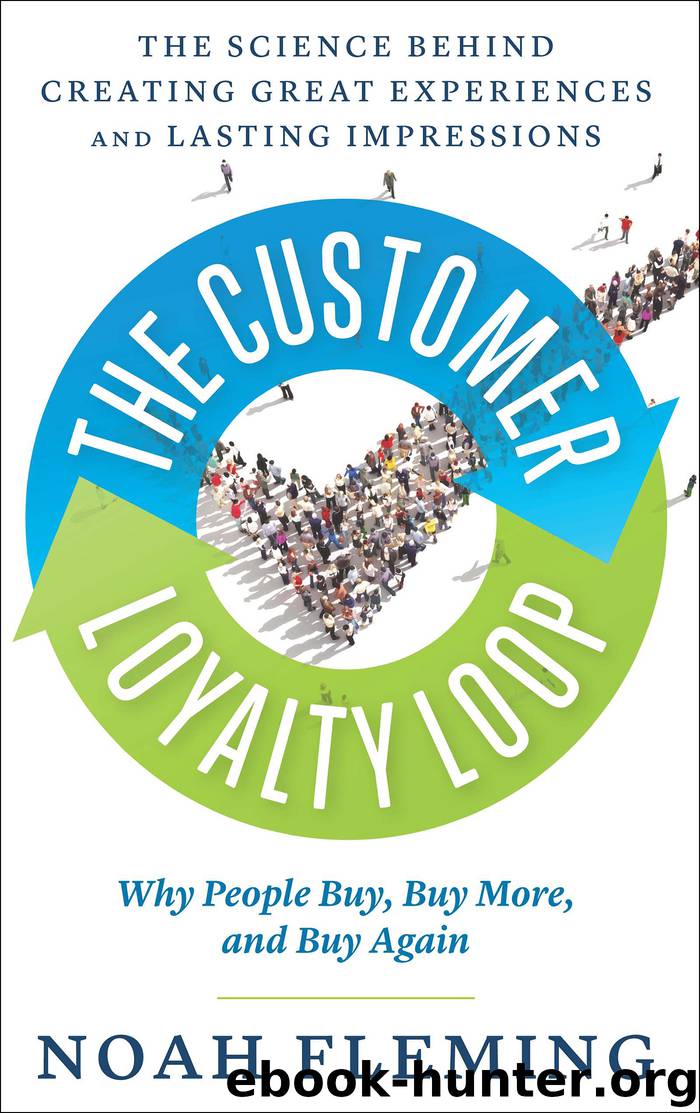The Customer Loyalty Loop by Noah Fleming

Author:Noah Fleming
Language: eng
Format: epub
Publisher: Red Wheel Weiser
Published: 2017-04-22T16:00:00+00:00
Three Types of Resistance
Knowles argues that there are three types of resistance. The first, he says, is reactance. Reactance is the resistance against the persuasion process itself. People aren’t idiots. They know when they’re being sold and pitched, and they resist it. They react by essentially saying, “Look, I understand what you’re trying to do here, and I don’t like it! Leave me alone.”
If you think about today’s digitally connected world, is it any surprise that this might be the single largest driver of customer resistance? Think of the last time you stepped foot on a new car lot. You see the salesman from outside; he narrows in on you like an eagle stalking its prey, and he starts walking toward you. Furniture stores are incredibly guilty of this. You walk in, and you’re swarmed by a hungry seller hoping for a small bump in commissions on her next paycheck.
We’ve all felt this type resistance to the sales experience, and we react to it. It’s only more amplified today, and you need to be aware of it if you are interested in increasing customer loyalty. Contrast that to Elon Musk and Tesla, who have removed almost all friction from the buying process, by effectively letting you build your car online and press the checkout button without ever having to talk to a salesperson. This is what I’m talking about when we talk about the science of the customer experience. How much reactance–resistance are your selling efforts creating? Is your sales process built on the tactics of persuasion to move the customer to action, or do you work to remove the resistance early?
The second type of resistance is skepticism. We’ve all felt skepticism about an offer. You’ve heard the line “If it seems too good to be true, it probably is.” Clever marketers have used influence techniques to blast past the skepticism resistance, but you’ll never create a long-term loyal customer if that’s the case. They feel it. Deep within their souls, the feeling of skepticism will always linger. Skepticism isn’t always deceptive. Sometimes it’s simply the feeling that “You know, this product looks great, but I’m not sure it’s the right one for me.” Again, in Stage Two we have an excellent opportunity to deal with skepticism by understanding it’s there and building our customer experience and sales process to ensure it’s always dealt with before the sale, rather than after.
The third type of resistance is inertia. Knowles argues that this type of resistance isn’t caused by the persuader but by the prospect herself. Knowles says this is as disappointing for salespeople as it feels like their prospects are being rude, unresponsive, and so on. In those cases, it’s more likely that the other causes of resistance are the reason why they’re holding out. Salespeople that call too often and follow-up too much, for example, start to seem desperate. I’ve made this mistake numerous times in my career. I haven’t dealt with the reactance or skepticism, and I’ve lost the business because of it.
Download
This site does not store any files on its server. We only index and link to content provided by other sites. Please contact the content providers to delete copyright contents if any and email us, we'll remove relevant links or contents immediately.
Bad Blood by John Carreyrou(6583)
Rich Dad Poor Dad by Robert T. Kiyosaki(6513)
Principles: Life and Work by Ray Dalio(6296)
Playing to Win_ How Strategy Really Works by A.G. Lafley & Roger L. Martin(6083)
Management Strategies for the Cloud Revolution: How Cloud Computing Is Transforming Business and Why You Can't Afford to Be Left Behind by Charles Babcock(4546)
The Confidence Code by Katty Kay(4220)
Thinking in Bets by Annie Duke(4185)
American Kingpin by Nick Bilton(3819)
Delivering Happiness by Tony Hsieh(3396)
Project Animal Farm: An Accidental Journey into the Secret World of Farming and the Truth About Our Food by Sonia Faruqi(3189)
The Power of Habit by Charles Duhigg(3094)
The Tyranny of Metrics by Jerry Z. Muller(3028)
Brotopia by Emily Chang(3026)
Mastering Bitcoin: Programming the Open Blockchain by Andreas M. Antonopoulos(3011)
The Marketing Plan Handbook: Develop Big-Picture Marketing Plans for Pennies on the Dollar by Robert W. Bly(3006)
I Live in the Future & Here's How It Works by Nick Bilton(2960)
The Content Trap by Bharat Anand(2887)
Applied Empathy by Michael Ventura(2864)
Building a StoryBrand by Donald Miller(2863)
